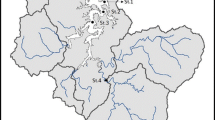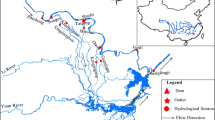Abstract
Long-term discharge of turbid water from reservoirs after flood events is a major socioenvironmental problem in many countries, including Korea. This study used a suite of mathematical models to simulate the fate of turbidity flows in the Soyanggang Reservoir in Korea, an important source of drinking water for the Seoul Capital Area, in response to extreme floods based on the Representative Concentration Pathway 4.5 climate scenario. It evaluated the effectiveness of the selective withdrawal facility (SWF), installed recently in the Soyanggang Reservoir to control persistent turbidity. Extreme floods with a maximum daily inflow rate greater than the historical maximum observed in 2006 were projected to occur four times in this century. The fate and transport of turbidity flows were highly influenced by both the thermal stability of the reservoir and the season in which the flood event occurred. Thus, SWF operations should consider the timing of extreme events (i.e., the imminence of the autumn turnover) to mitigate the impact of high turbidity on the water supply and downstream ecosystem. It was found to be ineffective under extreme events if these occurred in two consecutive years. Current reservoir operations, which rely heavily on the SWF, are likely to be inadequate to overcome the negative effects of extreme-turbidity events on reliably providing safe water supplies. Coping with the worst event expected to occur in the future would require additional countermeasures such as bypassing high-turbidity water.




Similar content being viewed by others
References
Achete F, van der Wegen M, Roelvink JA, Jaffe B (2017) How can climate change and engineered water conveyance affect sediment dynamics in the San Francisco Bay-Delta system? Clim Chang 142:375–389
Ahlfeld D, Joaquin A, Tobiason TJ, Mas D (2003) Case study: impact of reservoir stratification on interflow travel time. J Hydraul Eng 129:966–975
Ahn SR, Ha R, Yoon SW, Kim SJ (2014) Evaluation of future turbidity water and eutrophication in Chungju Lake by climate change using CE-QUAL-W2. J Korea Water Resour Assoc 47:145–159
Baek HJ, Lee JH, Lee HS, Hyun TK, Cho CH, Kwon WT, Marzim C, Gan SY, Kim MJ, Choi DH, JH1 L, JH2 LEE, Boo KO, Kang HS, Byun YH (2013) Climate change in the 21st century simulated by HadGEM2-AO under representative concentration pathways. Asia-Pac J Atmos Sci 49(5):603–618
Bates BC, Kundzewicz ZW, Wu S, Palutikof JP (eds) (2008) Climate change and water. Technical paper of the Intergovernmental Panel on Climate Change. IPCC Secretariat, Geneva 210 pp
Bouraoui F, Grizzetti B, Granlund K, Rekolainen S, Bidoglio G (2004) Impact of climate change on the water cycle and nutrient losses in a Finnish catchment. Clim Chang 66:109–126
Brekke LD, Maurer EP, Anderson JD, Dettinger MD, Townsley ES, Harrison A, Pruitt T (2009) Assessing reservoir operations risk under climate change. Water Resour Res 45:W04411
Chapra SC, Boehlert B, Fant C, Bierman VJ, Henderson J, Mills D, Mas DML, Rennels L, Jantarasami L, Martinich J, Strzpek KM, pearl HW (2017) Climate change impacts on harmful algal blooms in U.S. freshwaters: a screening-level assessment. Environ Sci Technol 51:8933–8943
Chung SW, Hipsey MR, Imberger J (2009) Modelling the propagation of turbid density inflows into a stratified lake: Daecheong Reservoir, Korea. Environ Model Softw 24:1469–1482
Cole TM, Scott AW (2015) CE-QUAL-W2: a two-dimensional, laterally averaged, hydrodynamic and water quality model, version 3.72
Davies-Colley RJ, Smith DG (2001) Turbidity suspended sediment, and water clarity: a review. J Am Water Resour Assoc 37:1085–1101
Deere D, Leusch F, Humpage A, Cunliffe D, Khan S (2017) Hypothetical scenario exercises to improve planning and readiness for drinking water quality management during extreme weather events. Water Res 111:100–108
Fischer HB, List EJ, Koh R, Imberger J, Brooks NH (1979) Mixing in inland and coastal waters. Academic, New York
Gelda RK, Effler SW (2007) Modeling turbidity in a water supply reservoir: advancements and issues. J Environ Eng 133:139–148
Gelda RK, Effler SW, Peng F (2012) Modeling turbidity and the effects of alum application for a water supply reservoir. J Environ Eng 138:38–47
Gelda RK, Effler SW, Prestigiacomo AR, Peng F, Effler AJP, Wagner BA, Perkins M, O’Donnell DM, O’Donnell SM, Pierson DC (2013) Characterizations and modeling of turbidity in a water supply reservoir following an extreme runoff event. Inland Waters 3:377–390
Glasgow HB, Burkholder JM, Reed RE, Lewitus AJ, Kleinman JE (2004) Real-time remote monitoring of water quality: a review of current applications, and advancements in sensor, telemetry, and computing technologies. J Exp Mar Biol Ecol 300:409–448
Gosling SN, Arnell NW (2016) A global assessment of the impact of climate change on water scarcity. Clim Chang 134:371–385
Gu R, Chung SW (1998) Reservoir flow sensitivity to inflow and ambient parameters. J Water Resour Plan Manag 124:119–128
Han JH, Kim DJ, Kang BS, Chung SW, Jang WS, Lim KJ, Kim JG (2017) Potential impacts of future extreme storm events on streamflow and sediment in Soyang-dam watershed. J Korean Soc Water Environ 33:160–169
Henley WF, Patterson MA, Neves RJ, Lemly A (2000) Effects of sedimentation and turbidity on lotic food webs: a concise review for natural resource managers. Rev Fish Sci 8:125–139
Hipsey MR, Imberger J, Paparini A, Antenucci JP, Soncini-Sessa R, Vincenzo-Spica R (2007) Towards a dynamic and adaptive system for real-time decision support in aquatic environments. Proceedings of the 32nd International Association for Hydraulic Reserch, Venice, Italy
Hong ES (2007) Measurement of weathering degree and classification of weathering class. Land Technol 71:177–201
Hong SJ, Kim BS, Ha SR (2014) Climate change impact assessment on Han River long term runoff in South Korea based on RCP climate change scenario. Terr Atmos Ocean Sci 25:689–701
IPCC (2012) Managing the risks of extreme events and disasters to advance climate change adaptation, A special report of Working Groups I and II of the Intergovernmental Panel on Climate Change. Cambridge University Press, Cambridge
Jeong JH, Kannan N, Arnold J, Glick R, Gosselink L, Srinivasan R (2010) Development and integration of sub-hourly rainfall-runoff modeling capability within a watershed model. Water Resour Manag 24:4505–4527
Kang BS, Moon SJ (2017) Regional hydroclimatic projection using an coupled composite downscaling model with statistical bias corrector. KSCE J Civ Eng 21(7):2991–3002
Khan SJ, Deere D, Luesch F, Humpage A (2015) Extreme weather events: should drinking water quality management systems adapt to changing risk profiles? Water Res 85:124–136
Kim BS, Kim BK, Kwon HH (2011) Assessment of the impact of climate change on the flow regime of the Han River basin using indicators of hydrologic alteration. Hydrol Process 25:691–704
Kim SJ, Kim JW, Kim BW (2015) Last glacial maximum climate over Korean Peninsula in PMIP3 simulations. Quat Int 384:52–81
Kondolf GM, Gao Y, Annandale GW, Morris GL, Jiang E, Zhang J, Cao Y, Carling P, Fu K, Hotchkiss R, Peteuil C, Sumi T, Wang HW, Wang Z, Wei Z, Wu B, Wu C, Yang CT (2014) Sustainable sediment management in reservoirs and regulated rivers: experiences from five continents. Earth’s Future 2(5):256–280
Korea Environment Institute (2005) Effective turbid water management of multi-purpose dam reservoir through watershed management. ISBN 89-8464-156-1, South Korea
Lee GS, Kim JY, Ahn SR, Sim JM (2010) Analysis of suspended solid of Andong and Imha Basin according to the climate change. J Korean Assoc Geogr Inf Stud 13:1–15
Lee HW, Kim EJ, Park SS, Choi JH (2015) Effects of climate change on the movement of turbidity flow in a stratified reservoir. Water Resour Manag 29:4095–4110
Lee CH, Lee YC, Chiang HM (2016) Abrupt state change of river water quality (turbidity): effect of extreme rainfalls and typhoons. Sci Total Environ 557–558:91–101
Leigh C, Bush A, Harrison E, Ho S, Luke L, Rolls RJ, Ledger ME (2015) Ecological effects of extreme climatic events on riverine ecosystems: insights from Australia. Freshw Biol 60:2620–2638
Li Z, Clark RM, Buchberger SG, Yang YJ (2014) Evaluation of climate change impact on drinking water treatment plant operation. J Environ Eng 140(9):A4014005
Matonse AH, Pierson DC, Frei A, Zion MS, Anandhi A, Schneiderman E, Wright B (2013) Investigating the impact of climate change on New York City’s primary water supply. Clim Chang 116:437–456
Mitsuzumi, A, Kato M, Omoto Y (2009) Effect of sediment bypass system as a measure against long-term turbidity and sedimentation in dam reservoir. In: 23rd ICOLD congress, Brasilia, Brazil. Q89-R8
Monier E, Gao X (2015) Climate change impacts on extreme events in the United States: an uncertainty analysis. Clim Chang 131:67–81
Neff R, Chang H, Knight C, Najjar R, Yarnal B, Walker H (2000) Impact of climate variation and change on Mid-Atlantic Region hydrology and water resources. Clim Res 14:207–218
Neitsch SL, Arnold JG, Kiniry JR, Williams JR (2009) Soil and water assessment tool theoretical documentation, version 2009
Quinn JM, Davies-Colley RJ, Hickey CW, Vickers ML, Ryan PA (1992) Effects of clay discharges on streams. 2. Benthic invertebrates. Hydrobiologia 248:235–247
Read JS, Hamilton DP, Jones ID, Muraoka K, Winslow LA, Kroiss R, Wu CH, Gaiser E (2011) Derivation of lake mixing and stratification indices from high-resolution lake buoy data. Environ Model Softw 26:1325–1336
Samal NR, Matonse AH, Mukundan R, Zion MS, Pierson DC, Gelda RK, Schneiderman EM (2013) Modelling potential effects of climate change on winter turbidity loading in the Ashokan Reservoir, NY. Hydrol Process 27:3061–3074
Samal NR, Wollheim W, Zuidema S, Stewart R, Zhou Z, Mineau MM, Borsuk M, Gardner KH, Glidden S, Huang T, Lutz D, Mavrommati G, Thorn AM, Wake CP, Huber M (2017) A coupled terrestrial and aquatic biogeophysical model of the Upper Merrimack River watershed, New Hampshire, to inform ecosystem services evaluation and management under climate and land-cover change. Ecol Soc 22(4):18. https://doi.org/10.5751/ES-09662-220418
Sobieszczyk S, Uhrich MA, Bragg HM (2007) Major turbidity events in the North Santiam River basin, Oregon, water years 1999–2004: U.S. Geological Survey scientific investigations report 2007–5178, USA
Temba N, Chung SO (2014) Uncertainty of hydro-meteorological predictions due to climate change in the Republic of Korea. J Korea Water Resour Assoc 47:257–267
Umeda M, Yokoyama K, Ishikawa T (2006) Observation and simulation of floodwater intrusion and sedimentation in the Shichikashuku Reservoir. J Hydraul Eng 132:881–891
USACE (US Army Corps of Engineers) (2013) HEC-ResSim Reservoir System Simulation
Wang S, Qian X, Han BP, Luo LC, Ye R, Xiong W (2013) Effects of different operational modes on the floodinduced turbidity current of a canyon-shaped reservoir: case study on Liuxihe Reservoir, South China, Hydrol. Process., 27:4004–4016
Weiss WJ, Pyke GW, Becker WC, Sheer DP, Gelda RL, Rush PV, Johnstone TL (2013) Integrated water quality-water supply modeling to support long-term planning. J Am Water Works Assoc 105(4):E217–E228
Weyhenmeyer GA, Müller RA, Norman M, Tranvik LJ (2016) Sensitivity of freshwaters to browning in response to future. Clim Chang 134:225–239
Yajima H, Kikkawa S, Ishiguro J (2006) Effect of selective withdrawal system operation on the longand short-term water conservation in a reservoir. Ann J Hydraul Eng 50:1375–1380
Ye L (2008) Impact of climate change on water cycle and soil loss in Daecheong reservoir watershed (Masters dissertation), Chungbuk University, Korea
Funding
This work is supported by the Korea Agency for Infrastructure Technology Advancement (KAIA) grant funded by the Ministry of Land, Infrastructure and Transport (Grant 17AWMP-B083066-04).
Author information
Authors and Affiliations
Corresponding authors
Additional information
Publisher’s Note
Springer Nature remains neutral with regard to jurisdictional claims in published maps and institutional affiliations.
Electronic supplementary material
ESM 1
(DOCX 1424 kb)
Rights and permissions
About this article
Cite this article
Park, H., Chung, S., Cho, E. et al. Impact of climate change on the persistent turbidity issue of a large dam reservoir in the temperate monsoon region. Climatic Change 151, 365–378 (2018). https://doi.org/10.1007/s10584-018-2322-z
Received:
Accepted:
Published:
Issue Date:
DOI: https://doi.org/10.1007/s10584-018-2322-z




